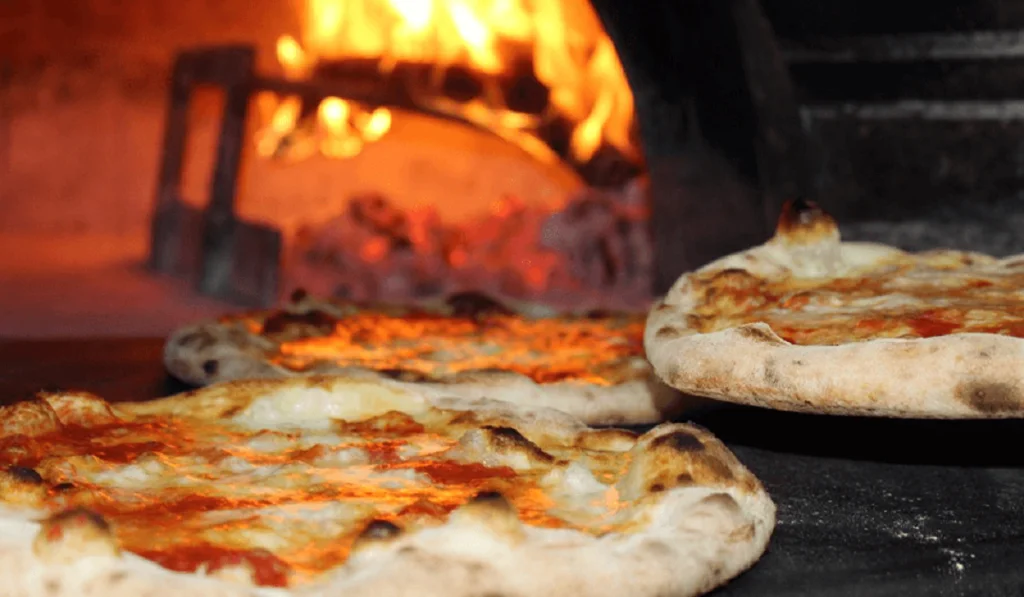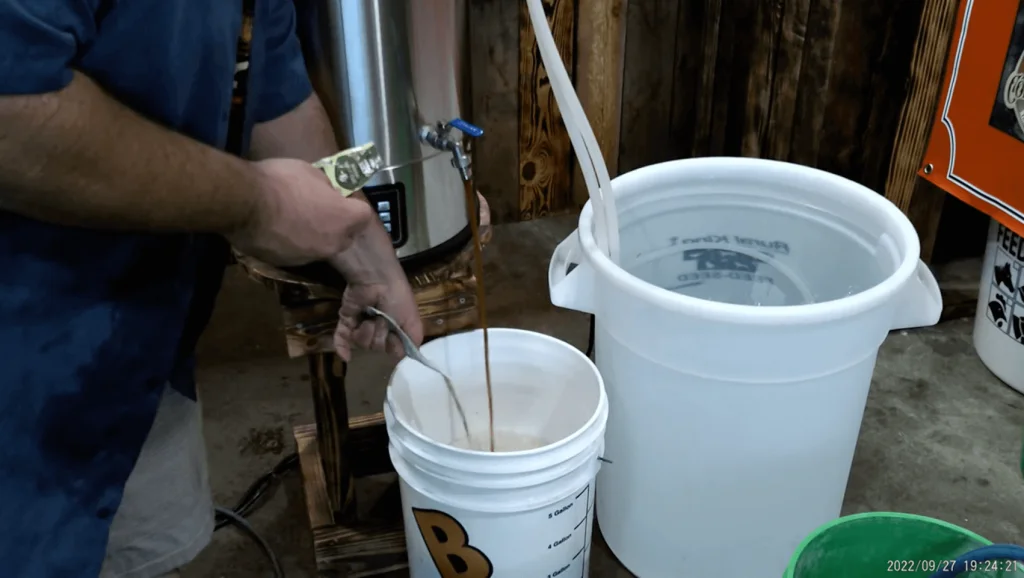Originating from the sun-kissed streets of Naples, Italy, in the 1700s, wood-fired pizza ovens are more than mere cooking apparatus; they are time-honored companions to the art of perfect pizza making. With their origins deeply rooted in Italy, these ovens have become synonymous with authenticity, transforming the act of pizza preparation into a sacred ritual. So, congratulations on finally joining the ranks of elites in backyard pizza making.
But what if you don’t know how to use a wood-fired pizza oven? Don’t worry, we’ve all been there. Using a wood-fired pizza oven for the first time can be daunting. You have to manage the flames and keep the pizza from burning while cooking at high temperatures.
In this guide, we’ll discuss cooking pizza in a wood-fired oven, explore the science behind these ovens, unlock the secrets of building the perfect fire, and guide you through the art of crafting delicious pizzas. So, let’s get baking!
Table of contents
How Does a Wood-Fired Oven Work?
Wood-fired pizza ovens are marvels of engineering. They are designed to cook perfect pizzas with a crispy crust and smoky flavor by using wood as the primary fuel source. Here are a few things to understand how a wood-fired pizza oven works:
1. Types of Heat Transfer in Wood-Fired Pizza Oven
To achieve the distinctive crispy crust and smoky flavor, wood-fired pizza ovens cook pizza with three main types of heat transfers:
- Conduction: Heat transfer by direct contact. For example, the pizza dough directly touching the hot pizza stone cooks through conduction.
- Convection: Heat transfer through the movement of heated air. In a wood-fired oven, some heat transfer occurs through convection as hot air circulates within the dome.
- Radiation: Heat transfer via electromagnetic waves. This is the primary heat transfer mechanism in wood-fired ovens. The flames and hot oven walls emit infrared radiation that uniformly cooks the pizza from all sides.
2. The Power of the Dome
The distinctive dome shape of a wood-fired oven plays a crucial role in its efficiency. The curved surface reflects radiant heat inwards, ensuring consistent cooking and minimizing heat loss. It also helps in heat retention, allowing the oven to maintain high temperatures for extended periods.
3. Types of Wood-Fired Ovens
Wood-fired pizza ovens come in various designs, each with its unique characteristics. Here are three common types:
- Brick Ovens: These are the most traditional type, built with refractory bricks that can withstand high temperatures. They offer excellent heat retention and are ideal for consistent cooking results.
- Metal Ovens: These are the most modern type, often constructed from stainless steel. They heat up quickly and are relatively easy to maintain. However, they may not retain heat as well as brick ovens.
Now that you understand the science behind wood-fired ovens let’s delve into the practical side of things and learn how to use them effectively.
How to Use a Wood-Fired Pizza Oven?
There is more to the perfect pizza making than just buying a well-designed wood-fired pizza oven. If you are using a wood-fired pizza oven for the first time, follow these steps to make sure that you are doing everything right:
Preparation
- Gather the necessary tools and equipment: These include a pizza peel, a long-handled brush for cleaning the oven floor, a fire starter, a thermometer to monitor the temperature, and protective gloves.
- Choose the right type of wood: Hardwoods such as oak, maple, and hickory are ideal for wood-fired ovens. Avoid softwoods like pine, which burn too quickly and may impart a bitter taste to the pizza.
- Prepare the oven floor: Remove any ash or debris from the floor and preheat it for at least 30 minutes before adding the pizza.
Building the Fire
- Create Controlled Fire: Start with small kindling and gradually add larger pieces of wood. This creates a controlled fire that heats the oven evenly.
- Maintain a consistent fire temperature: Aim for a temperature between 700°F and 800°F (371°C and 427°C). Use the thermometer to monitor the temperature.
- Manage fire carefully: Use a long-handled pizza peel to manage the fire. Push the burning logs around to create even heat distribution and remove any large embers that may burn the pizza.
Cooking the Pizza Oven Recipes
Once the oven reaches the desired temperature, carefully use your ember mover or ember rake to move the fire to the back of the oven or either side. If you are thinking of cooking directly on the pizza stone, make sure that it is as clean as possible.
For pizza, make sure that it is placed a bit distance from the fire. Pizza cooks fast (in about 90 seconds), so make sure you have your eyes on it. Halfway through the cooking, consider rotating the pizza to ensure that it is evenly cooked.
For other dishes, check the oven temperature before you put the food inside the oven. For more heat, consider placing the food closer to the fire and further away for lesser heat.
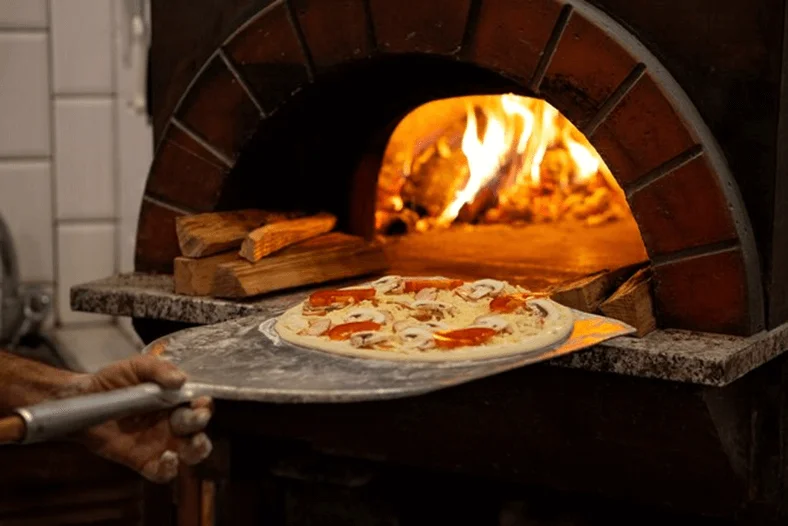
How to Cook Pizza in a Wood-Fired Oven?
Mastering the art of cooking pizza in a wood-fired oven goes beyond simply firing up the flames. It requires careful preparation, skilled assembly, and precise timing.
Dough Preparation
- Choose a pizza dough recipe suitable for wood-fired ovens. These doughs tend to be high in hydration, which allows them to cook quickly and achieve a crispy crust without burning.
- Knead the dough properly for a good texture. Aim for a smooth and elastic dough that springs back when pressed.
- Let the dough rise in a warm, draft-free environment. This allows the gluten to relax and develop, resulting in a light and airy crust.
Toppings and Ingredients
- Choose toppings for the desired taste, also ensuring that they are compatible with wood-fired cooking. Some vegetables, like mushrooms and onions, benefit from pre-cooking to ensure they are tender when the pizza finishes cooking.
- Prepare the toppings beforehand for efficiency. Some toppings, such as raw chicken, ground meat, sausage, fish, shellfish, and pork, need to be precooked. Similarly, some veggies, such as onions and mushrooms, also need to be precooked. So, consider preparing these toppings beforehand to make the assembly process smooth and stress-free.
Assembling and Baking the Pizza
- Crafting the Canvas: Stretch the dough to the desired size and shape. Use your fingertips to gently stretch the dough from the center outwards, forming a thin and even crust. Avoid using a rolling pin, as it can deflate the air bubbles, leading to a dense pizza base. Also, consider leaving the edges a bit thicker than the rest.
- Saucing the Foundation: Once the dough is stretched to the desired size and shape, spread the pizza sauce across the flattened pizza dough, ensuring every bite is flavorful.
- Layering Cheese: Now that you have spread sauce, add a generous layer of cheese to it.
- Add Toppings: Add the desired toppings evenly across the dough after adding cheese. Avoid overloading the pizza, as this can make it soggy and difficult to cook.
- Adding Another Cheese Layer: If you love cheese, add another layer on top of the toppings for an irresistible gooey finish.
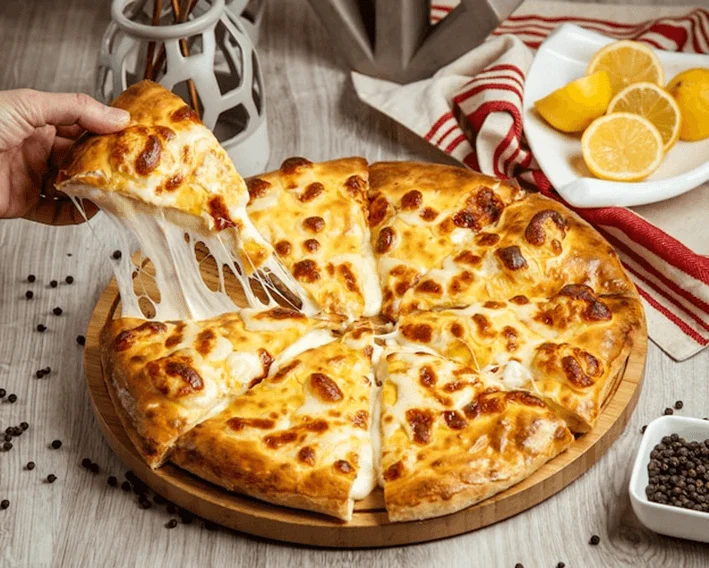
Cooking the Pizza
Once the pizza is assembled, it is time to let the pizza oven do its magic.
- Slide Pizza in the Oven: Once assembled, slide pizza onto the pizza stone using a pizza peel. Make sure that the pizza oven temperature is ideal, and be gentle, smooth, and swift when transferring pizza from the pizza peel to the pizza stone to prevent toppings from falling off. Also, make sure that you do not place the pizza too close to the fire.
- Rotate the Pizza: Wood-fired pizza ovens cook pizza fast. Cooking pizza in a wood-fired oven takes around 90 seconds, depending on the temperature of the oven. So, after placing the pizza inside the oven, keep your eyes on the pizza and rotate it to ensure even cooking. If need be, regulate the temperature by distancing the pizza from the fire. Time is of the essence when you place pizza into the oven. So, no thinking twice. Do whatever you think needs to be done confidently. And sweat not if it does not come out as good as you wanted, especially if you are using a wood-fired pizza oven for the first time. Move on to the next dough. And remember, experimenting is the key.
By following these steps and practicing regularly, you’ll soon be crafting restaurant-quality pizzas in your backyard with your wood-fired pizza oven.
Choosing the Best Wood-Fired Pizza Oven for Your Needs
If you are having a hard time finding the right wood-fired pizza oven for your needs, consider the following factors to make sure that you pick the right one.
Size and Capacity
Consider the size of your cooking space and the number of people you typically cook for. If you have a limited outdoor area and plan to cook for small gatherings, a portable small to medium wood-fired oven might be ideal for you.
Budget
Wood-fired pizza ovens are expensive compared to gas-fired pizza ovens and electric pizza ovens. But today, many cheaper options are also available in wood-fired pizza ovens. So, set a realistic budget before you start shopping and prioritize features that matter most to you.
Fuel Type
Wood-fired pizza ovens are designed to burn wood. However, some models can also support burning charcoal, pellets, and even gas. Different fuel options come in handy when you are short on wood.
Special Features
Some pizza ovens come with additional helpful features like built-in thermometers, pizza stones, and chimney dampers. These features can enhance your cooking experience and make it easier to achieve consistent results.
Manufacturing Material
Wood-fired pizza ovens are typically made from brick, clay, stainless steel, or a combination of these materials, each offering its own advantages and disadvantages.
Brick ovens are known for their excellent heat retention and traditional look, but they are also the most expensive and heaviest option. On the other hand, stainless steel pizza wood-fired pizza ovens are highly affordable, portable, and light in weight.
For instance, this VEVOR 12” Wood Fire Pizza Oven is only $169.99 (at the time of writing). Despite its tough and durable build, it is light in weight, and for maximum portability, it features two removable wheels.
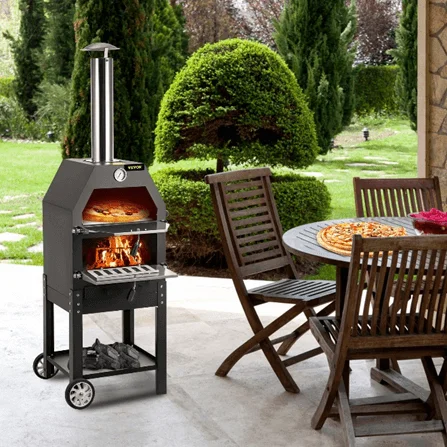
Portability
Consider how often you plan to move your oven. If you want to use it in different locations, you should go for a portable pizza oven, just like the one shared above.
Brand Reputation & Warranty
Wood-fired pizza ovens can be a huge investment, so consider looking into the brand’s reputation from which you plan on purchasing. Also, check if the brand offers any warranty.
At VEVOR, we not only offer a 30-day no-hassle return but also a 12-month warranty on all our products, including pizza ovens.
FAQs about Using a Wood-Fired Pizza Oven
How long does it take to heat up a wood-fired pizza oven?
The heating time for a wood-fired pizza oven depends on several factors, including the size of the oven, the type of wood used, and the desired temperature. Usually, it takes up to 1 hour to heat up a traditional wood-fired pizza oven fully. But this VEVOR 46” Wood-Fired Artisan Pizza Oven takes only 10 to 15 minutes to preheat and can reach temperatures as high as 1000ºF.
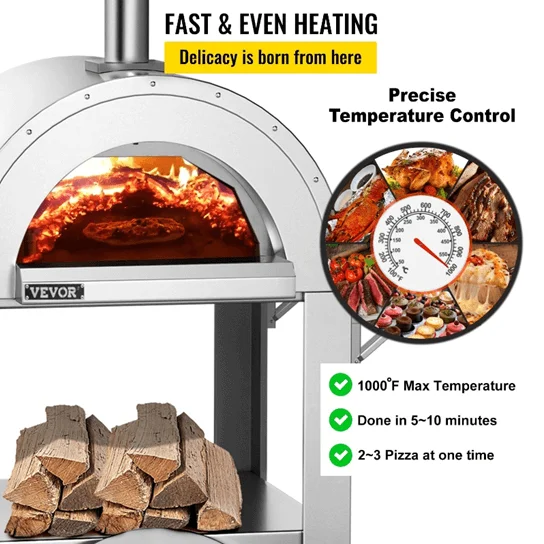
Can you use charcoal in a wood-fired pizza oven?
Yes, you can use charcoal in a wood-fired pizza oven, but you will have to be a bit more careful as charcoal tends to burn better and faster than wood. So, you might have a hard time managing the temperature of the oven.
What is the best wood for a wood-fired pizza oven?
It depends on your desired temperature range. However, hardwoods such as oak, maple, hickory, and mesquite wood tend to be the most popular and best for wood-fired pizza ovens.
How hot does a pizza oven have to be?
For optimal pizza cooking, your wood-fired pizza oven should reach a temperature between 700°F and 800°F. This high temperature ensures a crispy crust, properly melted cheese, and cooked toppings in a short time.
Conclusion
Using a wood-fired pizza oven for the first time can be a daunting task. If you do not know how to use a wood-fired pizza oven, follow the steps discussed above to ensure you do everything right. You might burn a couple of your first wood-fired pizzas but know that practice and experimentation are key to perfect pizza making. Keep experimenting with the dough, toppings, cooking temperature, and time; you will be crafting pizzeria-quality pizza in no time.
If you are looking for consistent results, you should make sure that you have a quality wood-fired pizza oven.

